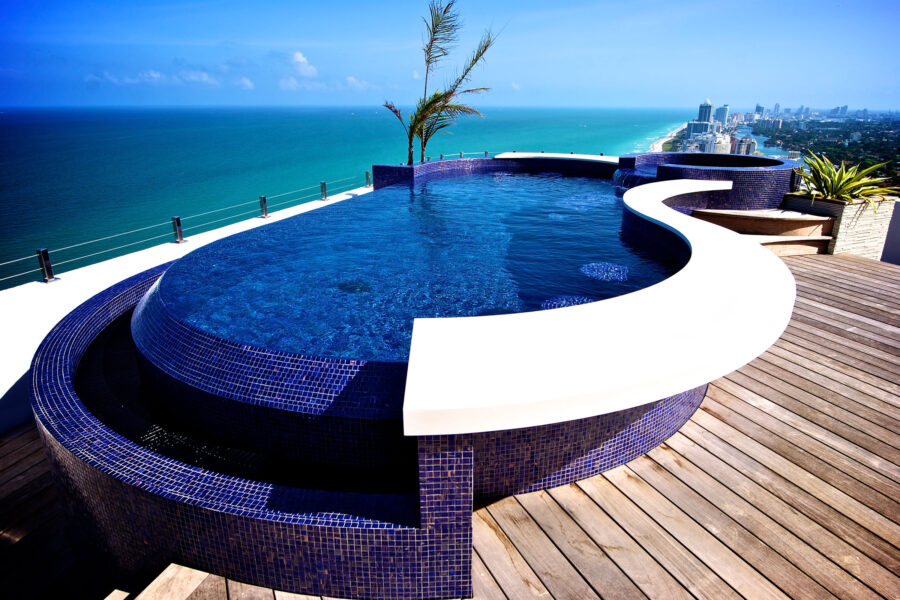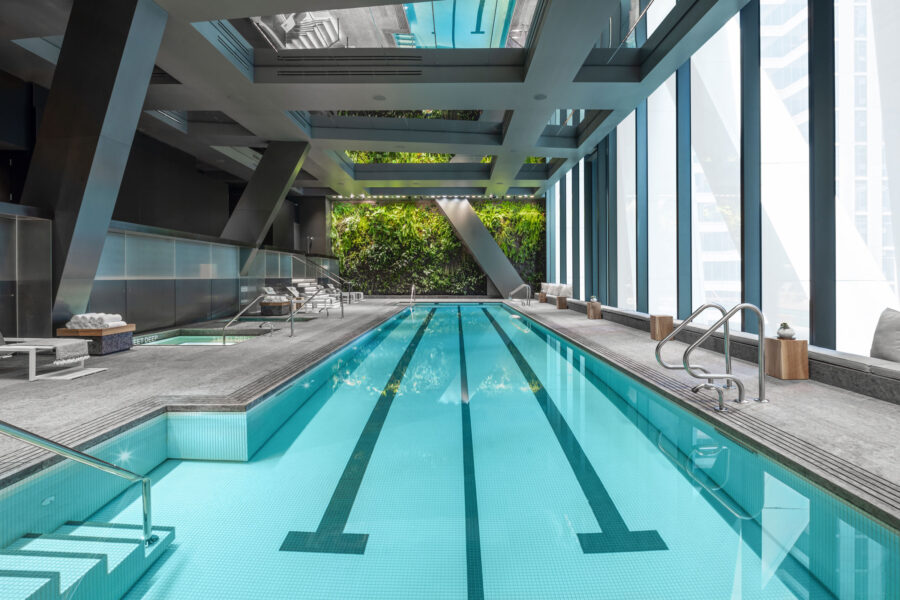Story at a glance:
- Stainless steel is a durable, lightweight material ideal for constructing custom pools and spas that require little maintenance.
- Bradford Products specializes in designing and engineering aquatic features that last decades and never leak.
- The company has a hands-on approach and can deliver even the most complex high-rise projects.
The high-end, high-rise hotels that dot the skylines of the hottest vacation locales from Miami to Las Vegas may have unique designs, features, and amenities, but many have one thing in common—a Bradford stainless steel pool or spa.
“For these types of applications stainless steel just makes the most sense—it’s lightweight and flexible but near indestructible,” says Andy Potter, director of engineering at Bradford Products, one of the original designers and manufacturers of stainless steel aquatics.
The North Carolina-based family firm, which recently celebrated its 40th year in operation, may be a worldwide leader in the luxury aquatics market, but the company has humble roots. Dale Brodeur, Bradford’s patriarch, got his start by making electrical panels in a sheet metal shop. It wasn’t until a trip to California in the 1970s, where he and his wife first experienced a redwood barrel hot tub, that he began experimenting with aquatic features.
Bradford has grown quickly over the past two decades, going from approximately 30 to 35 employees in 2005 to nearly 180 today—with 60 to 70 of those welders alone. This allows the company to ensure its vessels are constructed and installed to last decades without leaking.
“We started out really as just a hot tub operation before getting into the commercial side of things,” Potter says. “Small pools became big pools, and big pools became bigger pools. It just blew up from there.”
Potter sat down with gb&d to discuss the superiority of stainless steel and the process that makes Bradford’s pools and spas such high quality products.
Design Phase

Photo courtesy of Bradford Products
Every custom stainless steel pool and spa begins in the conceptual design phase. “Whether it starts on a napkin drawing a customer brings to us or from a professional architectural aquatic drawing, we work with internal and external designers to set the parameters for whatever the customer wants,” Potter says.
Once the customer has approved the conceptual drawings outlining the look, dimensions, and features of the aquatic vessel, Bradford’s engineers use SolidWorks to build 3D models of the vessels. This creates a framework for the shell of the vessel itself, all of the fittings, the gutter, the main drains, and any additional features the customer may add on.
From there the engineers export the model into AutoCAD into 2D drawings the customer reviews. Once the customer signs off the engineering team goes into what Potter calls the breakdown of the vessel. “In breakdown we take the 3D model we have drawn in SolidWorks and take the walls and steps of the vessel and lay them flat,” he says. “This creates what we call a flat pattern, and this is what the laser will use to cut the parts.”
These parts go into what is called the “shell book” for the shell of the vessel. Potter’s team then takes the specs for the frame and wall stiffeners and puts this information into a “frame book,” which contains the sizes, quantities, and lengths that will need to be sheared and bent.
Precision Engineering

Photo courtesy of Bradford Products
Once all of the design parameters have been set the engineering team lays all of the parts out flat and makes a cut list for angles and channels that will be cut. From there the material goes to the laser department, which uses the DWG files from SolidWorks that contain all the flat patterns for the shell and frame parts and cuts these into panels. “This ensures each piece is cut with exact precision and matches the specifications of the model,” Potter says.
Next the steel panels go to the brake department, which bends all of the pieces into place, and then the welding department will put those pieces on skids, build the frame, and then the shell. After that they put the stiffener system around it, tie everything together to make sure it fits well, and weld the shell out, Potter says.
Finally the vessel gets fitted for plumbing—including jets, drains, and the like—and if the customer wants to add tile to the shell, that’s installed before it is tested for quality control and is prepped to ship out onsite.
In addition to designing and engineering the vessels themselves, Bradford Products has recently began developing its own accessory products like jets, drains and drain covers, skimmers, and sump boxes.
“We used to use a plastic jet that relied on a gasket fitting to keep its water-tightness,” Potter says. But during the Covid pandemic, which caused procurement and supply chain issues for companies across the globe, the firm was unable to obtain these jets so it designed its own proprietary stainless steel jet, manufactured at a local machine shop, that can be welded into its vessels.
Seeing the benefits of doing this work in-house, Bradford also developed its own stainless steel main drain—which has been tested and approved by UL Solutions—as well as other parts like suction outlets and fitting assemblies.
Next Level Shipping and Installation

Aman NYC. Photo courtesy of Bradford Products
Once the vessel is complete Bradford Products ships it as a whole without welding the pieces together on shipping splits, tacking them in place. “If it’s a big vessel it may ship out in as many as 20 pieces,” Potter says.
Once the vessel has shipped Bradford’s team arrives onsite to help maneuver the pieces into place and weld them together completely to ensure water tightness. “Water tightness is one of the biggest selling points for a stainless steel pool or spa,” Potter says. “If you have a concrete pool it doesn’t matter how well it’s installed—it’s going to eventually leak, and you’re going to have to repair it.”
This, plus the durability of stainless steel, allows Bradford to provide a 25-year warranty on the shell of the pool or spa.
Most single-family residential projects are relatively straightforward to install, but high-rise hotel and residential jobs can require a bit of creativity. That was the case with the Akoya Penthouse in Miami Beach—a remodel of a 48th floor luxury condo where the owners hoped to install a 23-foot tiled pool with an infinity spillover edge and attached circular hot tub.
Since concrete could not be poured on the roof of an existing building, stainless steel was the obvious material choice. Yet the pieces were too large to bring to the roof by elevator. The Bradford team drafted a plan to build the entire vessel in sections and transport the pieces to the roof by helicopter. Because stainless steel is a lighter material, the pool and spa wouldn’t threaten the integrity of the building, and the project was up in running in a few weeks’ time.
Importance of Stainless Steel
“Stainless steel is the ideal product for pools,” Potter says. It’s highly versatile and easily shaped, which gives architects and designers the flexibility to create visually stunning aquatic features.
At the same time stainless steel is exceptionally durable and can withstand extreme elements and harsh conditions. It’s also highly resistant to corrosion and rust, which gives it a far longer lifespan than concrete. For property owners and managers, this means less time and effort on maintenance and less money spent on repairs.
“Stainless steel is great, but the quality of the stainless steel we use makes a big difference,” Potter says. Everything the firm works with is sourced from the US.
Bradford typically uses grade 304L and 316L stainless steel for 95% of its projects. There are even higher quality options for those looking to build saltwater pools. “On occasion we use 2205 duplex material that holds up far greater to salt systems and mineral vessels where you have high concentration of different chemicals,” Potter says.
And while stainless steel is more durable than concrete, it’s also far lighter—generally one-quarter to one-third the weight of concrete. This makes it not only easier to ship, but quicker to install.
This also relates to its impact on the environment, as stainless steel requires far less energy to transport and install. On top of that, it’s 100% recyclable—with no loss to the quality of the steel.
Benefits of Bradford Products
Bradford Products is hardly the only designer and manufacturer of stainless steel aquatic vessels, but there are a number of reasons the firm has become the go-to provider of pools and spas for the top developers of high-rise hotels, apartments, and condos. “The biggest thing that makes us stand out from competitors is our ability to pretty much do anything in the process from start to finish,” Potter says.
The company’s size allows it to leverage the economies of scale, and developing some of its own accessory devices like stainless steel jets and drains has limited the pain caused by supply chain issues while providing a higher quality product.
“We’ve got a 25-year warranty for our shells, all of our welders are AWS-certified, and the pride in the craftsmanship they have shows in our products,” Potter says. “Once you see what other people consider to be adequate, you really notice the quality of our guys on the shop floor.”


